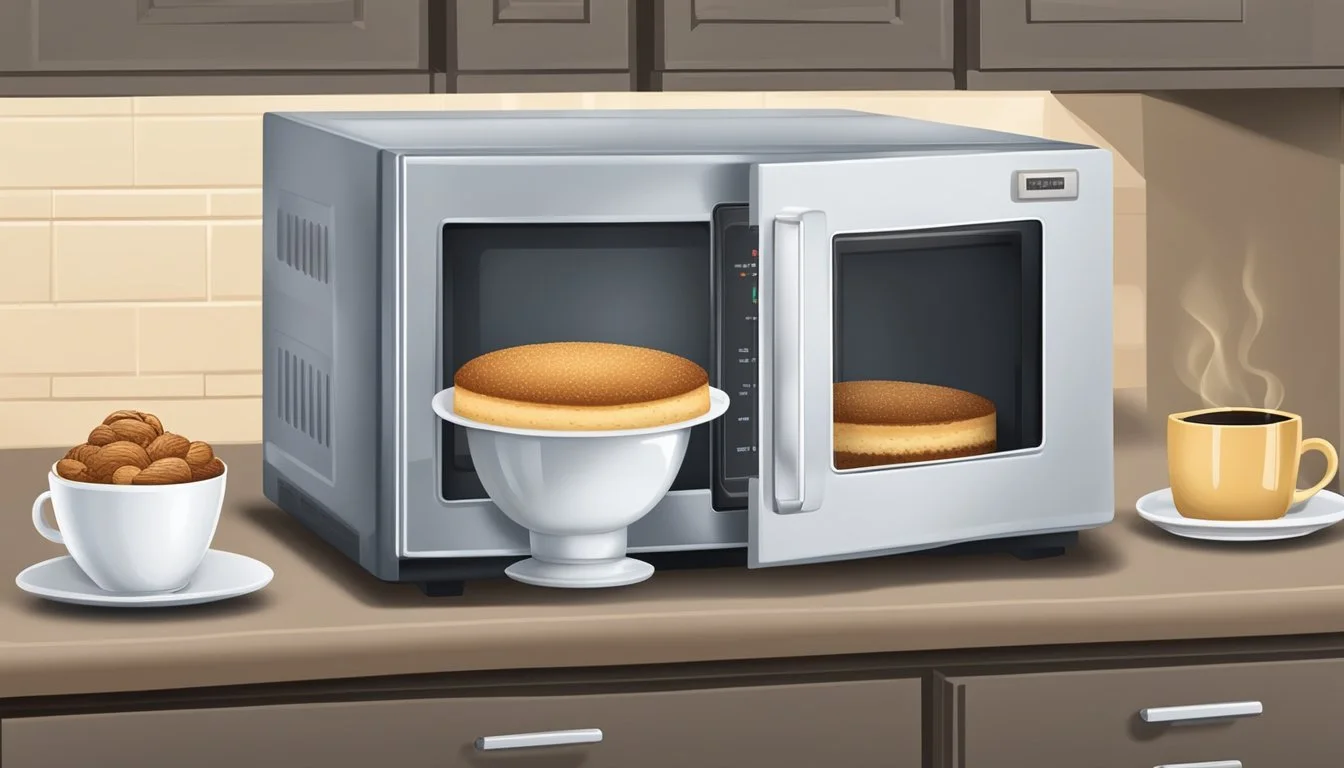How to Reheat Coffee Cake
Tips for Moist and Delicious Results
Reheating coffee cake to restore its delicious flavor and moist texture is an art worth mastering. The best way to reheat coffee cake is by using an oven, which evenly warms the cake while preserving its original quality. Placing a slice or whole coffee cake in a preheated oven at 350°F for a few minutes ensures that each bite is as enjoyable as when it was freshly baked.
For those short on time, the microwave can be a quicker alternative. Although it may affect the cake's texture slightly by making it a bit soggy, heating in short bursts of 15-30 seconds can effectively warm individual slices of coffee cake. To maintain its moistness, it’s crucial not to overheat.
Proper storage also plays a critical role in how well your coffee cake reheats. If you anticipate enjoying your coffee cake over several days, keeping it covered or in an airtight container will help retain its freshness. Frozen coffee cake can be reheated in the oven, making it taste almost as if it just came out of the oven.
Understanding Coffee Cake
Coffee cake is a delightful treat characterized by its sweet and moist texture. It often features a streusel topping or filling, with common flavors including cinnamon, vanilla, and fruits or nuts.
Defining the Coffee Cake
Coffee cake is a type of cake intended to be enjoyed with coffee, typically served as a breakfast item or dessert. Despite its name, it rarely contains coffee. Instead, it is enjoyed alongside coffee.
The cake is typically sweet and moist, often incorporating a streusel topping or streusel filling for additional flavor and texture. This topping is usually a mix of sugar, butter, and cinnamon, providing a delicious contrast to the soft cake layer underneath. Coffee cake can be baked in various shapes, including squares, rectangles, and even bundt forms.
Common Ingredients
The foundational ingredients for coffee cake often include all-purpose flour, brown sugar, butter, salt, baking powder, milk, and eggs. For additional depth of flavor, bakers frequently add vanilla extract, cinnamon, and sour cream or buttermilk to the mix.
Streusel toppings commonly feature a blend of flour, butter, and sugar, often enhanced with the inclusion of cinnamon. Some recipes incorporate fruits such as berries or nuts like walnuts and pecans for added texture and flavor contrast.
Mixing these ingredients creates a balanced taste profile with a moist texture, making coffee cake a versatile and enjoyable treat.
Storing Coffee Cake
Proper storage of coffee cake is essential to maintain its texture and flavor. Whether you plan to keep it at room temperature, refrigerate, or freeze it for longer storage, the key steps ensure your coffee cake stays fresh and moist.
Room Temperature Storage
Coffee cake can be stored at room temperature for up to 2-3 days. Before storing, it should be wrapped tightly in plastic wrap or aluminum foil to prevent it from drying out.
For added protection, place the wrapped cake in an airtight container. This method keeps air and moisture out, preserving the cake's crumb and preventing it from becoming stale. Avoid exposing the cake to direct sunlight or heat sources.
Refrigeration Tips
To extend the freshness beyond a few days, refrigeration is an effective option. First, wrap the coffee cake in plastic wrap or parchment paper to maintain its moisture.
Then, place it in an airtight container or a fridge-safe bag. Store the cake on a shelf rather than the door to avoid temperature fluctuations. When ready to eat, let the cake come to room temperature for a few minutes to regain its original texture.
Freezing for Longevity
Freezing is the best approach for long-term storage, keeping the coffee cake fresh for up to 2-3 months. Wrap the cake securely in plastic wrap and then in a layer of aluminum foil to prevent freezer burn.
Ensure there’s no air between the wrapping and the cake. Place the wrapped cake in a freezer-safe bag before storing it in the freezer. When you're ready to enjoy, thaw the cake in the fridge overnight, then let it sit at room temperature before serving to restore its softness.
Preparation Before Reheating
Proper preparation ensures your coffee cake remains moist and tender when reheating. Two key steps include bringing the cake to room temperature and checking its moisture content.
Bringing Cake to Room Temperature
Allowing the coffee cake to reach room temperature before reheating prevents it from drying out. Cold coffee cake can reheat unevenly, resulting in a mix of too dry and too moist sections.
Remove the coffee cake from the refrigerator and let it sit for about 20 to 30 minutes. This step is critical for maintaining the cake’s texture.
When ready, the cake should feel soft and not too cold to the touch. Ensuring it’s at room temperature aids in even reheating.
Checking Moisture Content
Assessing the moisture content of your coffee cake helps in deciding whether additional steps are needed to keep it tender. If the cake feels dry, consider adding moisture before reheating.
Prepare a simple sugar syrup by mixing equal parts water and sugar, then bring it just to a boil. Let it cool slightly, then poke a few holes on top of the cake with a skewer.
Using a spoon or pastry brush, evenly spread the syrup over the cake. This technique ensures the cake remains moist and flavorful after reheating. If the cake is already moist, you can skip this step and proceed to the reheating method of choice.
Reheating Techniques
Reheating coffee cake correctly ensures it retains its moist texture and delightful flavors. The two most popular methods are using an oven or a microwave. Here’s how to do it:
Oven Method
The oven method is ideal for reheating coffee cake as it helps maintain its original texture.
Preheat the Oven: Set the oven temperature to 350°F (175°C).
Prepare the Cake: Place the coffee cake in a baking dish. Cover it loosely with aluminum foil to prevent it from drying out.
Reheating: Heat the cake for 10-15 minutes. Check periodically to avoid overcooking.
Finishing Touch: Remove the foil for the last 2-3 minutes for a slightly crisp top if desired.
For best results, let the coffee cake rest for a few minutes after reheating. Serve warm to enjoy the revived flavors and texture.
Microwave Method
The microwave method is quicker but can result in a slightly different texture. Use this method for a fast reheating option.
Preparation: Place a slice of coffee cake on a microwave-safe plate.
Heating Process: Heat the cake at medium power (50-70% power level) for short intervals of 15-30 seconds. This helps in avoiding overcooking.
Moisture Retention: To prevent the cake from becoming soggy, cover loosely with a damp paper towel during reheating.
Immediate Consumption: Consume the coffee cake immediately after reheating as microwaving can make it dry quickly.
For a quick fix, the microwave method provides a convenient way to enjoy your coffee cake without compromising too much on taste.
By following these methods, you can enjoy your leftover coffee cake as if it were freshly baked.
Serving Suggestions
To elevate the experience of enjoying reheated coffee cake, consider pairing it with tasteful accompaniments. Enhancing the cake with complementary flavors can make the occasion more delightful.
Accompaniments
Whipped Cream: A dollop of freshly whipped cream can add a light and creamy contrast to the rich flavors of the warm coffee cake. It enriches every bite without overpowering the cake's original taste.
Vanilla Glaze: Drizzle a simple vanilla glaze over reheated coffee cake for added sweetness. The glaze melts slightly over the warm cake, creating a delicious blend of textures and flavors.
Streusel Topping: If your coffee cake lacks a streusel topping, consider adding one after reheating. Combine powdered sugar, butter, and flour, sprinkle over the top, and briefly warm it in the oven until golden and crispy.
Powdered Sugar: For a quick and easy enhancement, sift a light layer of powdered sugar over the cake. This addition improves the presentation and adds a subtle sweetness.
Cream and Coffee: Serve warm coffee cake with a cup of coffee or a glass of cream. The rich, bitter notes of coffee complement the sweetness of the cake, while cream can offer a smooth, balanced flavor.
Tips for Perfect Reheating
Storage: To ensure your coffee cake stays fresh, wrap each slice individually in plastic wrap or store in an airtight container. This helps retain moisture and prevent staleness.
Room Temperature: Let your coffee cake come to room temperature before reheating. This step helps in achieving even warming throughout the slice.
Oven Method: Preheat the oven to 300°F. Wrap the coffee cake in aluminum foil to lock in moisture. Place it on a baking sheet and heat for 10-15 minutes.
Microwave Method: Place a slice on a microwave-safe plate and cover with a damp paper towel. Heat for 15-30 seconds. Using a lower power setting can help reduce sogginess.
Air Fryer Method: Place the coffee cake on a small stand or rack inside the air fryer. Set the temperature to 200°F and heat for 5-10 minutes. Let it rest in the air fryer for a few minutes before serving.
Adding Moisture: To enhance the texture, brush the top of the cake with a bit of melted butter or softened butter before reheating. This can help achieve a golden finish and improve moisture.
Test for Warmth: Use a toothpick to check if the cake is warmed through. Insert the toothpick into the center of the slice. If it comes out warm, the cake is ready to eat.
Common Mistakes to Avoid
When reheating coffee cake, it's crucial to avoid certain pitfalls. Paying attention to overheating, preventing the drying effect, and using the correct utensils can help maintain the cake's texture and flavor.
Avoiding Overheating
Overheating is a common mistake that can ruin the texture of your coffee cake. Microwaves heat food quickly, but they can also cause uneven warming. To avoid this, use short bursts of 10-15 seconds. After each burst, check the cake's warmth. This method helps prevent the cake from becoming too hot and losing its moisture.
It's also advisable to avoid using high power settings. A low to medium setting ensures a more even distribution of heat. If you are reheating in an oven, set it to a low temperature, around 300°F, and keep a close watch. Use an oven thermometer to ensure the temperature remains steady.
Preventing Drying Effect
A major issue when reheating cake is drying it out. To minimize this, cover the cake with a damp paper towel before microwaving. This moisture barrier helps maintain the cake’s softness by trapping steam.
When using an oven, consider wrapping the cake loosely in foil. This method locks in moisture, preventing the cake from drying. Only uncover the last few minutes if you desire a slightly crisped top.
Additionally, avoid reheating more cake than you plan to consume immediately. Leftovers that are reheated multiple times will inevitably become dry. It's best to reheat only individual slices or portions.
Using Appropriate Utensils
Using the correct utensils can make a significant difference. Always place the cake on a microwave-safe plate when using a microwave. This prevents any harmful chemicals from leaching into your food. A plate that spreads heat evenly is preferable.
For cutting the cake before reheating, use a serrated knife. This type of knife minimizes crumbs and ensures a clean cut. Avoid using a blunt knife, which can crush the cake and cause unnecessary crumbling.
In an oven, place the cake on a baking sheet lined with parchment paper. This prevents sticking and makes cleanup easy. If freezing the cake before reheating, wrap it well in plastic wrap and then foil to protect against freezer burn.
Additional Resources
For those interested in delving deeper into the world of coffee cake, this section provides essential resources on making coffee cake from scratch and refining your baking skills through advanced techniques.
Making Coffee Cake at Home
Creating a homemade coffee cake can be both rewarding and delicious. There are numerous easy cake recipes that offer straightforward steps and accessible ingredients. Many recipes are available online, some of which include step-by-step videos to guide you through the process.
A basic coffee cake recipe typically involves ingredients like flour, sugar, butter, eggs, and a combination of spices such as cinnamon. For added flavor, consider incorporating fruits or nuts.
Here are a few resources for recipes and tutorials:
Allrecipes: Offers a variety of coffee cake recipes with ratings and reviews.
YouTube: Search for "homemade coffee cake recipe" to find instructional videos.
Food Network: Features expert recipes and tips from well-known chefs.
Advanced Baking Techniques
For those looking to elevate their baking skills, mastering advanced techniques can significantly improve the quality of your coffee cake. Techniques such as baking with steam and using a pastry brush to apply syrup can enhance texture and flavor.
Poking holes in the cake and pouring a sugar syrup mixture helps maintain moistness. Additionally, understanding the science of baking, such as how different types of flour affect texture, is valuable.
Key resources include:
Baking Blogs: Many professional bakers share tips on their personal blogs.
Cookbooks: Titles like "The Joy of Baking" contain detailed methods.
Online Baking Courses: Websites like MasterClass offer courses by renowned chefs.










